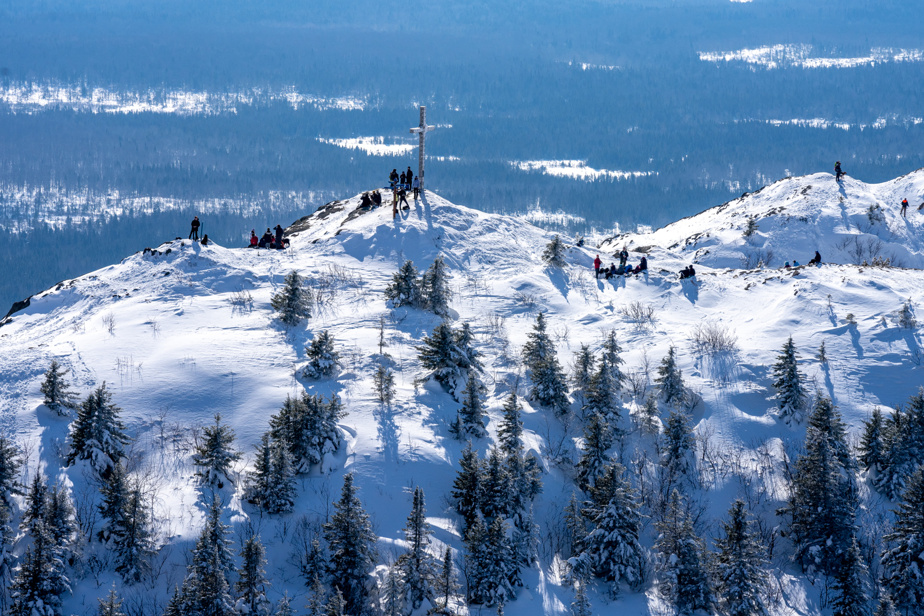Here we are at winter… The indigenous season which closes this series which began almost a year ago. It is the time of the great hunt, a period during which the majority of First Nations members go into the territory, and when the animals’ fur is at its most beautiful. Despite these very cold weather, it is the ideal time to stock up on supplies.

PHOTO YVES TREMBLAY, THE EYES OF THE SKY, SPECIAL COLLABORATION
The circle is an integral part of the traditions of indigenous communities. One of its most beautiful representations, recognized by UNESCO for its sustainable development criteria, are the streets of Ouje-Bougoumou. Arranged in a circular fashion, they make this village on the shore of Lake Opémisca unique in the world!

PHOTO YVES TREMBLAY, THE EYES OF THE SKY, SPECIAL COLLABORATION
January translates to the name Tshishe, which means “big” in Innu. This name tells us that it is the month of extremes, where the temperature is very cold. Ice forms all along the river, like here near Pessamit.

PHOTO YVES TREMBLAY, THE EYES OF THE SKY, SPECIAL COLLABORATION
Located in Wendake, a place where tradition rubs shoulders with modernity, the Hôtel-Musée des Premières Nations, inspired by the culture of the Huron-Wendats, is more revealed under a cover of snow. It was recently enlarged, notably by adding a new glass roof to the La Traite restaurant; all its rooms are on the same side and face the Akiawenrahk (Saint-Charles) River.

PHOTO YVES TREMBLAY, THE EYES OF THE SKY, SPECIAL COLLABORATION
All traces of this image seem to converge towards the traditional Innu Kanapeut site, where Innu culture comes back to life. Located north of Pessamit, it is a place of transmission of Innu-aitun, a culture that encompasses the way of life, the language, the link to the territory, spirituality and its values, in all seasons.

PHOTO YVES TREMBLAY, THE EYES OF THE SKY, SPECIAL COLLABORATION
Surrounded by a fortress, the Ekionkiestha’ national longhouse offers visitors, all year round, a journey to the heart of the Wendat way of life in the pre-contact era. During this experience, visitors have the opportunity to meet various storytellers, proud guardians of the ancestral wisdom of their people.

PHOTO YVES TREMBLAY, THE EYES OF THE SKY, SPECIAL COLLABORATION
When Nutshimit (“inland”, in Innu) meets the sea, nature offers us some of its most beautiful beauties only visible from the air, like this natural heart along the Nashipetimit (shore, in Innu).

PHOTO YVES TREMBLAY, THE EYES OF THE SKY, SPECIAL COLLABORATION
Located 12 km from Saint-Siméon, the Palissades de Charlevoix, a granite wall 4 kilometers wide and 400 meters high, are a natural mountain jewel unique in America. It is possible to cross a suspension bridge with a height of 60 meters.

PHOTO YVES TREMBLAY, THE EYES OF THE SKY, SPECIAL COLLABORATION
The height of the sugar loaf cone that forms at the foot of Montmorency Falls varies considerably from one year to the next, depending on the harshness of the winter. The bottom of the falls is accessible by a path in winter. We can see climbers there, because the path runs along the wall where ice climbing is practiced.

PHOTO YVES TREMBLAY, THE EYES OF THE SKY, SPECIAL COLLABORATION
Uashassihtsh, which means “small bay”, enjoys an exceptional location on the edge of Pekuakami (Lake Saint-Jean). This majestic place of Innu Uashassihtsh cultural transmission, in the heart of Mashteuiatsh, offers a window on the traditional way of life of the Pekuakamiulnuatsh (Innu of Lac-Saint-Jean).

PHOTO YVES TREMBLAY, THE EYES OF THE SKY, SPECIAL COLLABORATION
Who would have thought that excessive cutting could offer an artistic view, as is the case here in a lumberyard near Chibougamau. But while the trees are basking in their forest “resort”, we may wonder where moose, wolves and caribou can hide this winter?

PHOTO YVES TREMBLAY, THE EYES OF THE SKY, SPECIAL COLLABORATION
With these very steep cliffs, the acropolis of Draveurs, in the Hautes-Gorges-de-la-Rivière-Malbaie national park, in Charlevoix, offers us views of great richness, in addition to being a difficult trail , with a difference in altitude of 800 meters, more than four times the height of Place Ville Marie.
